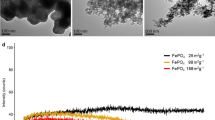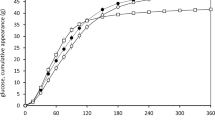Abstract
Background/Objectives
Fractional iron absorption (FAFe) from ferrous fumarate (FeFum) and ferrous sulfate (FeSO4) in adults is generally comparable. While FeFum is commonly used to fortify infant foods, FAFe from FeFum in young children and infants may be decreased compared with FeSO4 and this effect has not been assessed in inhibitory vs noninhibitory meals. Previous studies also reported FAFe to be strongly correlated in mother–child pairs. Our objective was to measure FAFe from fortified bread labeled with 58FeSO4 and 57FeFum in mother–child pairs with and without a commonly consumed herbal tea of Combretum micranthum (Tisane Kinkéliba, TK).
Methods
Senegalese mother–child pairs (n = 17) were randomly assigned to receive, in a 2 × 2 factorial design, fortified bread with 58FeSO4 or 57FeFum consumed with TK or water. FAFe was assessed by measuring erythrocyte incorporation of stable iron-isotopes 14 days after administration.
Results
In children, relative bioavailability (RBV) from FeFum was 51 and 64% compared with FeSO4 when served with TK or water (both, P < 0.05). In mothers, the presence of TK decreased FAFe by 56% (P < 0.05) and 50% (P = 0.077) and in children by 65 and 72% (both, P < 0.0001), in the meals with 58FeSO4 and 57FeFum, respectively. After adjustment for plasma ferritin, there was a positive correlation between FAFe in mothers and children (r = 0.4142, P = 0.001).
Conclusions
In Senegalese women and children, herbal tea decreased FAFe from a wheat-based meal. The RBV of FeFum was low in children but not in their mothers. FAFe was modestly correlated in mother–child pairs, possibly due to shared genetic, epigenetic or environmental background.
This is a preview of subscription content, access via your institution
Access options
Subscribe to this journal
Receive 12 print issues and online access
$259.00 per year
only $21.58 per issue
Buy this article
- Purchase on Springer Link
- Instant access to full article PDF
Prices may be subject to local taxes which are calculated during checkout

Similar content being viewed by others
References
Lynch S, Pfeiffer CM, Georgieff MK, Brittenham G, Fairweather-Tait S, Hurrell RF, et al. Biomarkers of nutrition for development (BOND)-iron review. J Nutr. 2018;148:1001S–67.
WHO. The world health report. Reducing risks, promoting healthy life. Geneva: WHO; 2002.
WHO/UNICEF. Focusing on anaemia. Towards an integrate approach for effective anaemia control. Geneva: WHO/UNICEF; 2004.
Ndiaye B, Siekmans K, Kung’u J, Wade S. Distribution of iron, vitamin A and zinc deficiencies in children and women in Senegal. Eur J Nutr Food Saf. 2015;5:908–9.
Lozoff B. Early iron deficiency has brain and behavior effects consistent with dopaminergic dysfunction. J Nutr 2011;141:740S–6.
Dunne JR, Malone D, Tracy JK, Gannon C, Napolitano LM. Perioperative anemia: an independent risk factor for infection, mortality, and resource utilization in surgery. J Surg Res. 2002;102:237–44.
Hass JD, Brownlie IV T. Iron deficiency and reduced work capacity: a critical review of the research to determine a causal relationship. J Nutr. 2001;131:676S–90.
Rasmussen KM. Is there a causal relationship between iron deficiency or iron deficiency anemia and weight a birth length of gestation and perinatal mortality? J Nutr. 2001;131:590S–601.
Brabin BJ, Hakimi M, Pelletier D. An analysis of anemia and pregnancy related maternal mortality. J Nutr. 2001;131:604S–14.
Fairweather-Tait S, Hurrel RF. Bioavailability of minerals and trace elements. Nutr Res Rev. 1996;9:295–324.
Mascitelli L, Goldstein MR. Inhibition of iron absorption by polyphenols as an anti-cancer mechanism. Q J Med. 2011;104:459–61.
Zimmermann MB, Harrington M, Villalpando S, Hurrell RF. Nonheme-iron absorption in first-degree relatives is highly correlated: a stable-isotope study in mother-child pairs. Am J Clin Nutr. 2010;91:802–7.
Cook JD, Boy E, Flowers C, Daroca M, del C. The influence of high-altitude living on body iron. Blood. 2005;106:1441–6.
Hurrell RF, Reddy M, Cook JD. Inhibition of non-heam iron absorption in man by polyphenolic-containing beverages. Br J Nutr. 1999;81:289–95.
Iwu MM. Handbook of African medicinal pants. Boca Raton: CRC Press; 2014.
Le Grand A. Anti-infective phytotherapies of the tree savannah, Senegal (occidental Africa). III: a review of phytochemical substances and the antimicrobial activity of 43 species. J Ethnopharmacol. 1989;25:315–38.
Welch C, Zhen J, Bassène E, Raskinn I, Simon JE, Wu Q. Bioactive polyphenols in kinkeliba tea (Combretum micranthum) and their glucose-lowering activities. J Food Drug Anal. 2017. https://doi.org/10.1016/j.jfda.2017.05.009.
Allen L, de Benoist B, Dary O, Hurell R, editors. Guidelines on food fortification with micronutrients. Geneva: WHO/FAO; 2006. http://apps.who.int/iris/bitstream/10665/43412/1/9241594012-eng.pdf. Accessed 22 Mar 2018.
Hurrell RF, Reddy MB, Dassenko SA, Cook JD. Ferrous fumarate fortification of a chocolate drink powder. Br J Nutr. 1991;65:271–83.
Sarker SA, Davidsson L, Mahmud H, Walczyk T, Hurrell RF, Gyr N, et al. Helicobacter pylori infection, iron absorption, and gastric acid secretion in Bangladeshi children. Am J Clin Nutr. 2004;80:149–53.
Perez-Exposito AB, Villalpando S, Rivera JA, Griffin IJ, Abrams SA. Ferrous sulfate is more bioavailable among preschoolers than other forms of iron in a milk-based weaning food distributed by PROGRESA, a national program in Mexico. J Nutr. 2005;135:64–9.
Harrington M, Hotz C, Zeder C, Polvo GO, Villalpando S, Zimmermann MB, et al. A comparison of the bioavalability of ferrous fumarate and ferrous sulfate in non-anemic Mexican women and children consuming a sweetened maize and milk drink. Eur J Clin Nutr. 2011;65:20–5.
WHO Multicentre Growth Reference Study Group. WHO child growth standards: length/height-for-age, weight-for-age, weight-for-length, weight-for-height and body mass index-for-age: methods and development. Geneva: World Health Organization; 2006. p. 132. http://www.who.int/childgrowth/standards/technical_report/en/.
WHO. Obesity: preventing and managing the global epidemic. Geneva, Switzerland: World Health Organization; 2000.
Erhardt JG, Estes JE, Pfeiffer CM, Biesalski HK, Craft NE. Combined measurement of ferritin, soluble transferrin receptor, retinol binding protein, and C-reactive protein by an inexpensive, sensitive, and simple sandwich enzyme-linked immunosorbent assay. J Nutr. 2004;134:3127–32.
Cook JD, Flowers CH, Skikne BS. The quantitative assessment of body iron. Blood. 2003;101:3359–64.
Folin O, Denis W. On phosphotungstic-phosphomolybdic compounds as color reagents. J Biol Chem. 1912;12:239–43.
McLean E, Cogswell M, Egli I, Wojdyla D, de Benoist B. Worldwide prevalence of anaemia, WHO Vitamin and Mineral Nutrition Information System, 1993-2005. Public Health Nutr. 2009;12:444–54.
Thurnham DI, Mc Cabe DL, Haldar S, Wieringa TF, Northrop-Clewes AC, Mc Cabe G. Adjusting plasma ferritin concentrations to remove the effects of subclinical inflammation in the assessment of iron deficiency: a meta-analysis. Am J Clin Nutr. 2010;92:546–55.
Paganini D, Uyoga MA, Cercamondi CI, Moretti D, Mwasi E, Schawab C, et al. Consumption of galacto-oligosaccharides increases iron absorption from a micronutrient powder containing ferrous fumarate and sodium iron EDTA: a stable-isotope study in Kenyan infants. Am J Clin Nutr. 2017;106:1020–31.
Walczyk T, Davidsson L, Zavaleta N, Hurrell RF. Stable isotope labels as a tool to determine the iron absorption by Peruvian school children from a breakfast meal. Fresenius J Anal Chem. 1997;359:445–9.
Kastenmayer P, Davidsson L, Galan P, Cherouvrier F, Hercberg S, Hurell RF. A double stable isotope technique for measuring iron absorption in infants. Br J Nutr. 1994;71:411–24.
Brown E, Hopper J, Hodges JL, Bradley B, Wennesland R, Yamauchi H. Red cell, plasma, and blood volume in healthy women measured by radiochromium cell-labeling and hematocrit. J Clin Investig. 1962;41:2182–90.
Linderkamp O, Versmold H, Riegel K, Betke K. Estimation and prediction of blood volume in infants and children. Eur J Paediatr. 1977;125:227–34.
Hosein F, Marsaglia G, Finch CA. Blood ferrokinetics in normal man. J Clin Investig. 1967;49:1–9.
Fomon SJ. Reflections on infant feeding in the 1970s and 1980s. Am J Clin Nutr. 1987;46:171–82.
Moretti D, Zimmermann MB, Wegmüller R, Walczyk T, Zeder C, Hurrell RF. Iron status and food matrix strongly affect the relative bioavailability of ferric pyrophosphate in humans. Am J Clin Nutr. 2006;83:632–8.
Sarker SA, Sultana S, Sattar S, Ahmed T, Beglinger C, Gyr N, et al. Influence of Helicobacter pylori infection on gastric acid secretion in pre-school Bangladeshi children. Helicobacter. 2012;17:333–9.
Howden CW, Hunt RH. Relationship between gastric secretion and infection. Gut. 1987;28:96–107.
Brown RC, Klein A, Simmons WK, Hurrell RF. The Influence of Jamaican herb teas and other polyphenol-containing beverages on iron-absorption in the rat. Nutr Res. 1990;10:343–53.
Hallberg L, Hulthen L. Prediction of dietary iron absorption: an algorithm for calculating absorption and bioavailability of dietary iron. Am J Clin Nutr. 2000;71:1147–60.
Zijp IM, Korver O, Tijburg LBM. Effect of tea and other dietary factors on iron absorption. Crit Rev Food Sci Nutr. 2000;40:371–98.
Ahmad Fuzi SF, Koller D, Bruggraber S, Pereira DI, Dainty JR, Mushtaq S. A 1-h time interval between a meal containing iron and consumption of tea attenuates the inhibitory effects on iron absorption: a controlled trial in a cohort of healthy UK women using a stable isotope iron. Am J Clin Nutr. 2017;106:1413–21.
Malfertheiner P, Megraud F, O’ Morain CA, Atherton J, Axon AT, Bazzoli F, et al. Management of Helicobacter pylori infection—the Maastrich IV/ florence consensus report. Gut. 2012;61:646–64.
Buerkli S, Ndiaye NF, Cercamondi CI, Herter-Aeberli I, Moretti D, Zimmermann MB. Asymptomatic Helicobacter Pylori infection in preschool children and young women does not predict iron bioavailability from iron-fortified foods. Nutrients. 2019;11:2093.
Roe MA, Collings R, Dainty JR, Swinkels DW, Fairweather-Tait SJ. Plasma hepcidin concentrations significantly predict interindividual variation in iron absorption in healthy men. Am J Clin Nutr. 2009;89:1088–91.
Magnusson B, Björn-Rassmussen E, Hallberg L, Rossander L. Iron absorption in relation to iron status. Model proposed to express results to food iron absorption measurements. Scand J Haematol. 1981;27:201–8.
Young MF, Glahn RP, Ariza-Nieto M, Inglis J, Olbina G, Westerman M, et al. Serum hepcidin is significantly associated with iron absorption from food and supplemental sources in healthy young women. Am J Clin Nutr. 2009;89:533–8.
Reddy MB, Hurrell RF, Cook JD. Estimation of nonheme-iron bioavailability from meal composition. Am J Clin Nutr. 2000;71:937–43.
Herter-Aeberli I, Eliancy K, Rathon Y, Loechl CU, Pierre JM, Zimmermann MB. In Haitian women and preschool children, iron absorption from wheat flour-based meals fortified with sodium iron EDTA is higher than that from meals fortified with ferrous fumarate, and is not affected by Helicobacter pylori infection in children. Br J Nutr. 2017;118:273–9.
Acknowledgements
We thank the women and children for their participation in the study, Dr Mamadou Sadji, Abdou Badiane, Ndèye Ndambao Sarr for their assistance.
Funding
This work was supported by the International Atomic Energy Agency (IAEA), by the Comité Sénégalais pour la Fortification des Aliments en Micronutriments (COSFAM), by the Ministère de l’Enseignement Supérieur et de la Recherche du Sénégal and Laboratory of Human Nutrition, ETH Zürich, Zürich, Switzerland.
Author information
Authors and Affiliations
Contributions
All the authors contributed to the study design, data analysis, and writing of the paper. NFN, NID, SB, AD, and DM carried out the field work, and CZ was responsible for the stable isotope analysis. CL participated in the statistical analysis. NFN and DM wrote the first draft of the paper. NFN and DM had primary responsibility for the final content and all authors contributed to its editing.
Corresponding author
Ethics declarations
Conflict of interest
The authors declare that they have no conflict of interest.
Additional information
Publisher’s note Springer Nature remains neutral with regard to jurisdictional claims in published maps and institutional affiliations.
Rights and permissions
About this article
Cite this article
Ndiaye, N.F., Idohou-Dossou, N., Bürkli, S. et al. Polyphenol-rich tea decreases iron absorption from fortified wheat bread in Senegalese mother–child pairs and bioavailability of ferrous fumarate is sharply lower in children. Eur J Clin Nutr 74, 1221–1228 (2020). https://doi.org/10.1038/s41430-020-0601-z
Received:
Revised:
Accepted:
Published:
Issue Date:
DOI: https://doi.org/10.1038/s41430-020-0601-z
This article is cited by
-
Herb-anticancer drug interactions in real life based on VigiBase, the WHO global database
Scientific Reports (2022)
-
The effect of a natural polyphenol supplement on iron absorption in adults with hereditary hemochromatosis
European Journal of Nutrition (2022)



